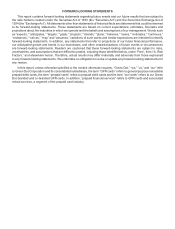Green Dot 2012 Annual Report Download - page 20
Download and view the complete annual report
Please find page 20 of the 2012 Green Dot annual report below. You can navigate through the pages in the report by either clicking on the pages listed below, or by using the keyword search tool below to find specific information within the annual report.10
Dividend Restrictions. Bank holding companies are subject to various restrictions that may affect their ability to
pay dividends. Federal and state banking regulations applicable to bank holding companies and banks generally
require that dividends be paid from earnings and, as described under “— Capital Adequacy” below, require minimum
levels of capital, which limits the funds available for payment of dividends. Other restrictions include the Federal Reserve
Board’s general policy that bank holding companies should pay cash dividends on common stock only out of net
income available to stockholders for the preceding year or four quarters and only if the prospective rate of earnings
retention is consistent with the organization’s expected future needs and financial condition, including the needs of
each of its bank subsidiaries. In the current financial and economic environment, the Federal Reserve Board has
indicated that bank holding companies should carefully review their dividend policies and has discouraged dividend
pay-out ratios that are at the 100% level unless both their asset quality and capital are very strong. A bank holding
company also should not maintain a dividend level that places undue pressure on the capital of its bank subsidiaries,
or that may undermine the bank holding company’s ability to serve as a source of strength for its bank subsidiaries.
See “— Source of Strength” below.
As part of our financial commitments to the Federal Reserve Board and Utah Department of Financial Institutions,
our subsidiary bank, Green Dot Bank, is restricted from paying dividends for 3 years from the date of acquisition.
Capital Adequacy. Bank holding companies and banks are subject to various requirements relating to capital
adequacy, including limitations on leverage. As a bank holding company that is a financial holding company, we are
required to be “well-capitalized,” meaning we must maintain a ratio of Tier 1 capital to risk-weighted assets of at least
6% and a ratio of total capital to risk-weighted assets of at least 10%. In addition, we are also subject to the generally
applicable bank holding company minimum Tier 1 leverage ratio of 4%, which is the ratio of Tier 1 capital to average
total consolidated assets. Tier 1 capital, or “core” capital, generally consists of common stockholders’ equity, perpetual
non-cumulative preferred stock and, up to certain limits, other capital elements. Tier 2 capital consists of supplemental
capital items such as the allowance for loan and lease losses, certain types of preferred stock, hybrid capital securities
and certain types of debt, all subject to certain limits. Total capital is the sum of Tier 1 capital plus Tier 2 capital.
Our subsidiary bank is also subject to separate capital and leverage requirements that we have committed to with
the Federal Reserve Board and Utah Department of Financial Institutions. As of December 31, 2012, we and our
subsidiary bank are each “well-capitalized” under the above standards and presently exceed our respective capital
and leverage commitments.
In December 2010, the international Basel Committee on Banking Supervision reached an agreement on new
risk-based capital, leverage and liquidity standards, known as “Basel III.” In June 2012, the Federal Reserve and other
U.S. banking regulators proposed rules to implement many aspects of Basel III in the United States. The U.S. Basel
III proposals contain new capital standards that would raise the quality of capital, increase minimum capital ratios and
strengthen counterparty credit risk capital requirements. The U.S. Basel III proposals also include a new definition of
common equity Tier 1 capital and would require that certain levels of such common equity Tier 1 capital be maintained.
The proposals also include a new capital conservation buffer, which would impose a common equity requirement above
the new minimum that can be depleted under stress, and could result in restrictions on capital distributions and
discretionary bonuses under certain circumstances, as well as a new standardized approach for calculating risk-
weighted assets.
Under the U.S. Basel III proposals, many of the new capital requirements were scheduled to take effect on January
1, 2013 and would be phased in over several years. The Federal Reserve and other U.S. banking regulators announced
in November 2012 that the U.S. Basel III proposals would not become effective on January 1, 2013. That announcement
did not state when the U.S. Basel III proposals would take effect.
Under the regulatory framework that Congress has established and bank regulators have implemented, banks
are either “well-capitalized,” “adequately capitalized,” “undercapitalized,” “significantly undercapitalized” or “critically
undercapitalized.” Banks are generally subject to greater restrictions and supervision than bank holding companies,
and these restrictions increase as the financial condition of the bank worsens. For instance, a bank that is not well-
capitalized may not accept, renew or roll over brokered deposits without the consent of the FDIC. If our subsidiary
bank were to become less than adequately capitalized, the bank would need to submit to bank regulators a capital
restoration plan that was guaranteed by us, as its bank holding company. The bank would also likely become subject
to further restrictions on activities, including entering into new lines of business or conducting activities that have the
effect of limiting asset growth or preventing acquisitions. A bank that is undercapitalized would also be prohibited from
making capital distributions, including dividends, and from paying management fees to its bank holding company if
the institution would be undercapitalized after any such distribution or payment. A significantly undercapitalized
institution would be subject to mandatory capital raising activities, restrictions on interest rates paid and transactions
with affiliates, removal of management and other restrictions. The FDIC has only very limited discretion in dealing with
a critically undercapitalized institution and is virtually required to appoint a receiver or conservator.
























